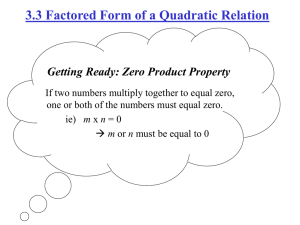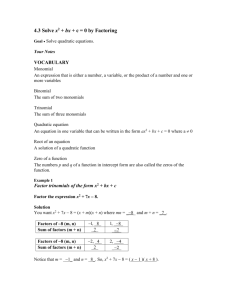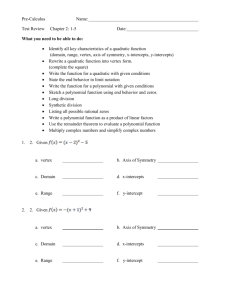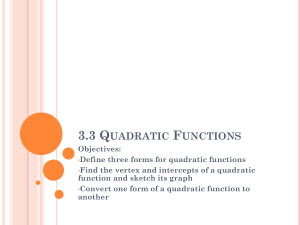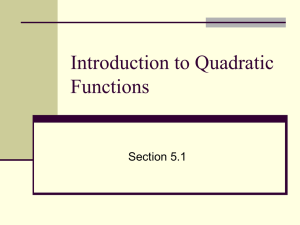Solutions to Exercises about Quadratic Functions
advertisement
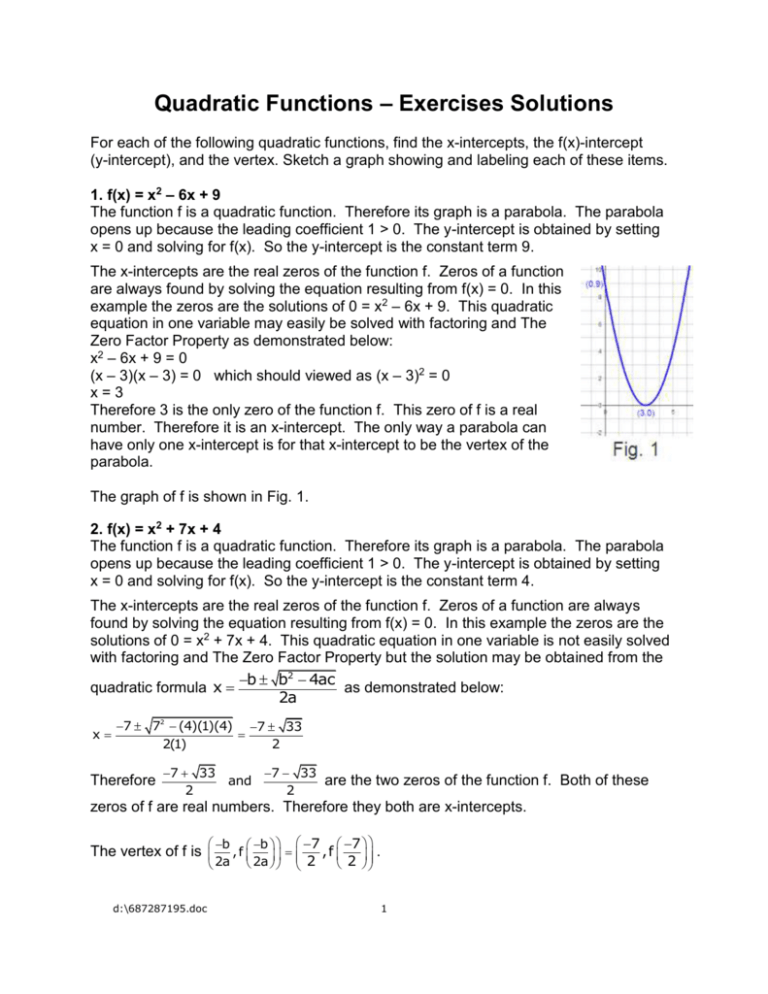
Quadratic Functions – Exercises Solutions For each of the following quadratic functions, find the x-intercepts, the f(x)-intercept (y-intercept), and the vertex. Sketch a graph showing and labeling each of these items. 1. f(x) = x2 – 6x + 9 The function f is a quadratic function. Therefore its graph is a parabola. The parabola opens up because the leading coefficient 1 > 0. The y-intercept is obtained by setting x = 0 and solving for f(x). So the y-intercept is the constant term 9. The x-intercepts are the real zeros of the function f. Zeros of a function are always found by solving the equation resulting from f(x) = 0. In this example the zeros are the solutions of 0 = x2 – 6x + 9. This quadratic equation in one variable may easily be solved with factoring and The Zero Factor Property as demonstrated below: x2 – 6x + 9 = 0 (x – 3)(x – 3) = 0 which should viewed as (x – 3)2 = 0 x=3 Therefore 3 is the only zero of the function f. This zero of f is a real number. Therefore it is an x-intercept. The only way a parabola can have only one x-intercept is for that x-intercept to be the vertex of the parabola. The graph of f is shown in Fig. 1. 2. f(x) = x2 + 7x + 4 The function f is a quadratic function. Therefore its graph is a parabola. The parabola opens up because the leading coefficient 1 > 0. The y-intercept is obtained by setting x = 0 and solving for f(x). So the y-intercept is the constant term 4. The x-intercepts are the real zeros of the function f. Zeros of a function are always found by solving the equation resulting from f(x) = 0. In this example the zeros are the solutions of 0 = x2 + 7x + 4. This quadratic equation in one variable is not easily solved with factoring and The Zero Factor Property but the solution may be obtained from the b b2 4ac quadratic formula x as demonstrated below: 2a x 7 72 (4)(1)(4) 7 33 2(1) 2 Therefore 7 33 2 and 7 33 are the two zeros of the function f. Both of these 2 zeros of f are real numbers. Therefore they both are x-intercepts. b b 7 7 The vertex of f is , f , f . 2 2a 2a 2 d:\687287195.doc 1 The range element associated with 7 is 2 2 49 49 7 7 7 f 2 7 2 4 4 2 4 2 49 2 49 4 4 49 16 33 4 4 4 4 4 2 2 7 33 Therefore the vertex is , 4 2 The graph of f is shown in Fig. 2. 3. f(x) = 8x2 – 2x – 7 The function f is a quadratic function. Therefore its graph is a parabola. The parabola opens up because the leading coefficient 8 > 0. The y-intercept is obtained by setting x = 0 and solving for f(x). So the y-intercept is the constant term – 7. The x-intercepts are the real zeros of the function f. Zeros of a function are always found by solving the equation resulting from f(x) = 0. In this example the zeros are the solutions of 0 = x2 – 6x + 9. This quadratic equation in one variable is not easily solved with factoring and The Zero Factor Property but the solution may be obtained from the b b2 4ac quadratic formula x as demonstrated below: 2a x 2 (2)2 (4)(8)(7) 2 228 2 2 57 1 57 2(8) 16 16 8 Therefore 1 57 8 and 1 57 are the two zeros of the function f. Both of these zeros 8 of f are real numbers. Therefore they both are x-intercepts. 1 1 The vertex of f is , f . 8 8 The range element associated with 1 is 8 2 1 2 56 57 1 1 1 f 8 2 7 8 8 8 8 8 8 8 1 57 Therefore the vertex is , 8 8 The graph of f is shown in Fig. 3. Notice that the graph seems to show one of the x-intercepts as (1,0). That erroneous conclusion stems from the fact that the resolution of the graph does not show the difference between 1 and 1.0687. d:\687287195.doc 2 4. f(x) = 5x2 – 14x – 3 The function f is a quadratic function. Therefore its graph is a parabola. The parabola opens up because the leading coefficient 5 > 0. The y-intercept is obtained by setting x = 0 and solving for f(x). So the y-intercept is the constant term – 3. The x-intercepts are the real zeros of the function f. Zeros of a function are always found by solving the equation resulting from f(x) = 0. In this example the zeros are the solutions of 0 = 5x2 – 14x – 3. This quadratic equation in one variable may easily be solved with factoring and The Zero Factor Property as demonstrated below: 5x2 – 14x – 3 = 0 (x – 3)(5x + 1) = 0 By the Zero Factor Property x = 3 or x 1 5 1 are the two zeros of the function f. Both of these 5 zeros of f are real numbers. Therefore they both are x-intercepts. Note that the factoring gives an alternate form for the rule of f. Therefore 3 and 1 f(x) = 5x2 – 14x – 3 = (x 3) x . This can be used to simplify 5 computations when finding range elements. 14 14 7 7 , f . 10 10 5 5 7 is The range element associated with 5 7 15 64 7 7 7 8 f 3 5 1 7 1 8 5 5 5 5 5 5 The vertex of f is ,f 7 64 Therefore the vertex is , 5 5 The graph of f is shown in Fig. 4. 5. f(x) = x2 + 10 x + 25 Begin by observing the right side of the rule is a perfect square so that f(x) = x2 + 10 x + 25 = (x + 5)2 The function f is a quadratic function. Therefore its graph is a parabola. The parabola opens up because the leading coefficient 1 > 0. The y-intercept is obtained by setting x = 0 and solving for f(x). So the y-intercept is the constant term 25. The x-intercepts are the real zeros of the function f. Zeros of a function are always found by solving the equation resulting from f(x) = 0. In this example the zeros are the solutions of 0 = (x + 5)2. Clearly – 5 is the only solution for this equation and it is a real number. Therefore it is an x-intercept. The only way a parabola can have only one x-intercept is for that x-intercept to be the vertex of the parabola. The graph of f is shown in Fig. 5. d:\687287195.doc 3 10. f(x) = – x2 – 2x + 3 Begin by observing the right side of the rule is factorable so that f(x) = – x2 – 2x + 3 = (-1)(x2 + 2x – 3) = (-1)(x + 3)(x – 1) The function f is a quadratic function. Therefore its graph is a parabola. The parabola opens down because the leading coefficient – 1 < 0. The y-intercept is obtained by setting x = 0 and solving for f(x). So the y-intercept is the constant term 3. The x-intercepts are the real zeros of the function f. Zeros of a function are always found by solving the equation resulting from f(x) = 0. In this example the zeros are the solutions of 0 = (x + 3)(x – 1). This quadratic equation in one variable may easily be solved with factoring and The Zero Factor Property as demonstrated below: (x + 3)(x – 1) = 0 By the Zero Factor Property x = – 3 or x = 1 Therefore – 3 and 1 are the two zeros of the function f. Both of these zeros of f are real numbers. Therefore they both are x-intercepts. b b The vertex of f is , f 1, f(1) . 2a 2a The range element associated with -1 is f(-1) = (–1)( – 1+ 3)( – 1 – 1) = (– 1)(2)( – 2) = 4 Therefore the vertex is (– 1, 4) The graph of f is shown in Fig. 10. Fig. 10A shows both the graph of f and its opposite. Observe the x-intercepts are the same. Why? Observe every point on the graph of f is reflected through the x-axis to obtain the graph of its opposite. Why? Observe the graph of the opposite of f opens in the opposite direction as does the graph of f. Why? 11. f(x) = x2 + 1 The function f is a quadratic function with positive leading coefficient. Therefore its graph is a parabola which opens up. The y-intercept is obtained by setting x = 0 and solving for f(x). So the y-intercept is the constant term 1. The x-intercepts are the real zeros of the function f. Zeros of a function are always found by solving the equation resulting from f(x) = 0. In this example the zeros are the solutions of 0 = x2 +1. The only solutions for this equation are the complex numbers i . Therefore the function f has no x-intercepts. Comparison of f with the squaring function reveals the graph of f to be the graph of the squaring function shifted (translated) up by one unit. Therefore the vertex of f is (0,1) The graph of f is shown in Fig. 11. d:\687287195.doc 4 15. f(x) = – 5x2 + 5x Begin by observing the right side of the rule is factorable so that f(x) = – 5x2 + 5x = – 5x(x – 1) The function f is a quadratic function. Therefore its graph is a parabola. The parabola opens down because the leading coefficient – 5 < 0. The y-intercept is obtained by setting x = 0 and solving for f(x). So the y-intercept is 0. The x-intercepts are the real zeros of the function f. Zeros of a function are always found by solving the equation resulting from f(x) = 0. In this example the zeros are the solutions of 0 = – 5x2 + 5x. This quadratic equation in one variable may easily be solved with The Zero Factor Property as demonstrated below: – 5x(x – 1) = 0 By the Zero Factor Property x = 0 or x = 1 Therefore 0 and 1 are the two zeros of the function f. Both of these zeros of f are real numbers. Therefore they both are x-intercepts. b b 1 1 The vertex of f is , f , f . 2a 2a 2 2 1 The range element associated with is 2 5 1 11 5 1 f 5 1 4 2 22 2 2 1 5 Therefore the vertex is , 2 4 The graph of f is shown in Fig. 15. 18. f(x) = 3x2 + 12x + 16 The function f is a quadratic function. Therefore its graph is a parabola. The parabola opens up because the leading coefficient 3 > 0. The y-intercept is obtained by setting x = 0 and solving for f(x). So the y-intercept is the constant term 16. The x-intercepts are the real zeros of the function f. Zeros of a function are always found by solving the equation resulting from f(x) = 0. In this example the zeros are the solutions of 0 = 3x2 + 12x + 16. The discriminant of this quadratic is b2 4ac 122 (4)(3)(16) (12)(12) (12)(16) (12)(12 16) 12(4) 0 . Therefore the quadratic has two complex solution and no real solutions. The b b func tion has no x-intercepts. The vertex of f is , f 2, f 2 . The 2a 2a range element associated with -2 is f(– 2) = 3(– 22) + 12(– 2) + 16 = 4. Therefore the vertex is 2, 4 The graph of f is shown in Fig.18. 20) f(x) = x2 + 8x + 7 d:\687287195.doc 5 Begin by observing the right side of the rule is factorable so that f(x) = x2 + 8x + 7 = (x + 7)(x + 1) The function f is a quadratic function. Therefore its graph is a parabola. The parabola opens up because the leading coefficient 1 > 0. The y-intercept is obtained by setting x = 0 and solving for f(x). So the y-intercept is the constant term 7. The x-intercepts are the real zeros of the function f. Zeros of a function are always found by solving the equation resulting from f(x) = 0. In this example the zeros are the solutions of 0 = x2 + 8x + 7. This quadratic equation in one variable may easily be solved with The Zero Factor Property as demonstrated below: (x + 7)(x + 1) = 0 By the Zero Factor Property x = – 7 or x = – 1 Therefore – 7 and – 1 are the two zeros of the function f. Both of these zeros of f are real numbers. Therefore they both are x-intercepts. The line of symmetry is the vertical line x = – 4 midway between the x-intercepts. The vertex of f is on the line of symmetry so it is 4, f(4) . The range element associated with – 4 is f(– 4) = (– 4 + 7)( – 4 + 1) = (3)( – 3)= – 9. Therefore the vertex is (– 4, – 9) The graph of f is shown in Fig. 20 . d:\687287195.doc 6
